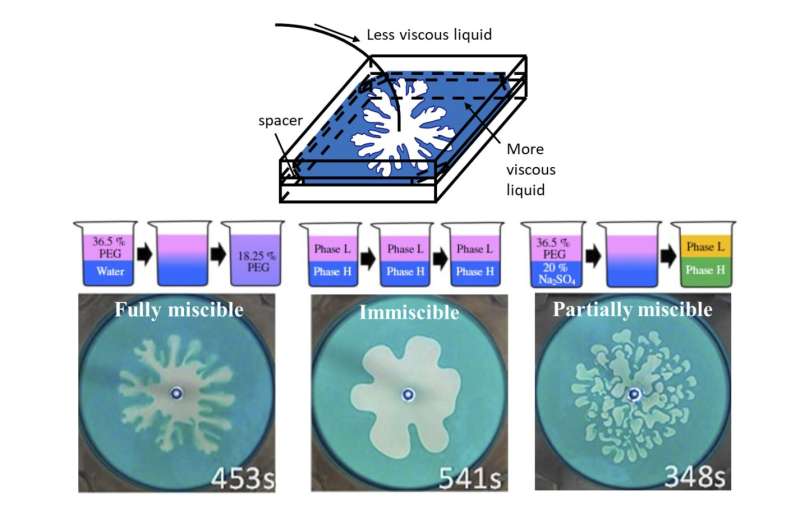New study may revise a 60-year-old theory about flowing viscous liquids

The international collaborative team of Tokyo University of Agriculture and Technology (TUAT) in Japan, Indian Institute of Technology Ropar (IIT Ropar) in India, and Osaka University in Japan has discovered for the first time a topological change of viscous fingering (one of classical interfacial hydrodynamics), which is driven by "a partially miscibility," where the two liquids do not mix completely with finite solubility. This topological change originates from a phase separation and the spontaneous motion driven by it. It is a phenomenon that cannot be seen with completely mixed (fully miscible) system with infinite solubility or immiscible system with no solubility.
The researchers published their results in the Journal of Fluid Mechanics on Jun 30th, 2020.
When a less viscous fluid displaces a more viscous fluid in porous media, the interface between the two fluids becomes hydrodynamically unstable and deforms in a finger shape. This phenomenon is technically called "Viscous fingering (VF)". Since the 1950s, the VF has been studied as one fluid dynamics issue. Then, it is now widely known that the properties can be classified according to weather the two fluids are fully miscible or immiscible. The viscous fingering dynamics helps to understand the process of fluid displacement in porous media in reactions and separation in chemical processes, as well as in enhanced-oil-recovery and CO2 sequestration.
"It has long been pointed out that viscous fingering in partially miscible fluids occurs in underground processes with high-pressure conditions, such as oil recovery and CO2 storage. However, such viscous fingering has been theoretically studied in the last few years," said Dr. Nagatsu, one of the corresponding authors on the paper and Associate Professor in the Department of Chemical Engineering at Tokyo University of Agriculture and Technology (TUAT). "Experimental studies of such VF have not been done at all. One of the reasons is that fluid mechanics researchers did not use experimental conditions that were partially miscible at room temperature and atmospheric pressure."
The research team succeeded in changing the miscibility of the system to fully miscible, immiscible, and partially miscible with little change in the viscosities at room temperature and atmospheric pressure. They used an aqueous two-phase system consisting of polyethylene-glycol (PEG), sodium-sulfate (Na2SO4), and water, which were described in the same research team's paper published in 2019. Here, in the partially miscible system, a pure PEG solution and a pure Na2SO4 solution dissolve each other with finite solubility, and as a result, the phase is separated into a PEG-rich phase (phase L) and a Na2SO4-rich phase (phase H).
They have carried out experiments by using this solution system in which a less-viscous liquid displaces a more-viscous one in a Hele-Shaw cell which is a model that mimics flow in porous media. "Our team found that topological change is observed in the case where the two liquids are partially miscible. This is the first instance of topological change in viscous fingering although various changes in the pattern due to various physicochemical effects, so far, have been reported when the two fluids are fully miscible or immiscible. We clearly showed this topological change originates from a phase separation occurring between the two fluids and the spontaneous motion driven by it," Nagatsu explains.
"Our result overturns the common understanding of more than 60 years in VF research which began in the 1950s that the characteristics of VF are divided into immiscible and fully miscible cases and it demonstrates the existence and importance of the partially miscible case, which becomes the third classification category. This will open a new cross-disciplinary research area involving hydrodynamics and chemical thermodynamics. Also, the displacement with partial miscibility in a porous medium takes places in the oil recovery process from the formation and the CO2 injection process into the formation. Thus, our finding is expected to create new control methodology of those processes by utilizing the partial miscibility," adds Nagatsu.
More information: Ryuta X. Suzuki et al, Phase separation effects on a partially miscible viscous fingering dynamics, Journal of Fluid Mechanics (2020). DOI: 10.1017/jfm.2020.406
Journal information: Journal of Fluid Mechanics
Provided by Tokyo University of Agriculture and Technology





















